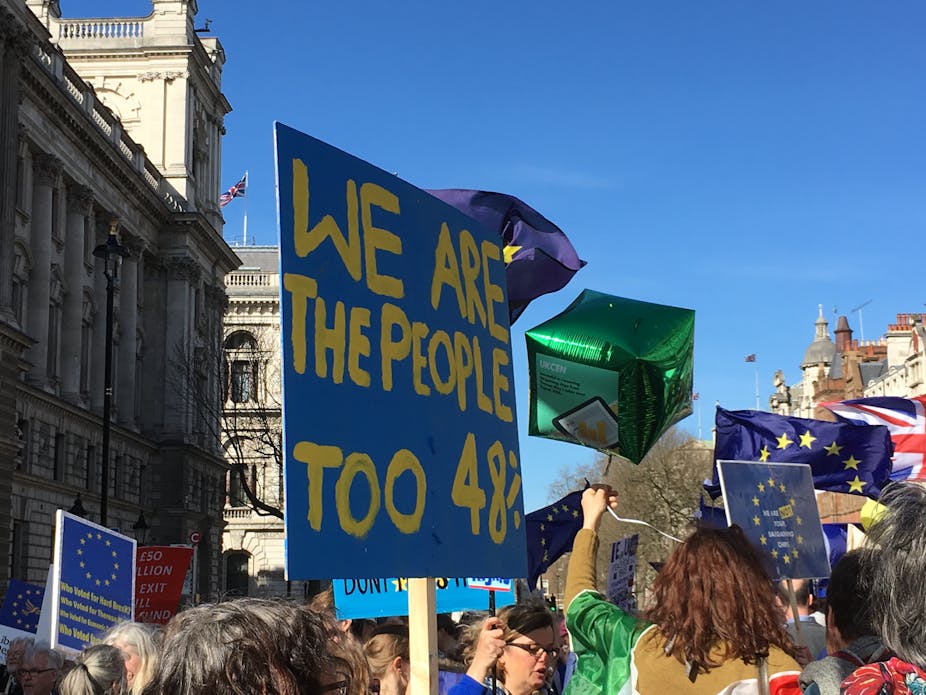According to some police estimates, which are rarely given to exaggeration, as many as 100,000 people marched across London on March 25 in support of the European Union, together with an estimated 1,000 to 1,500 in Edinburgh. The occasion was the 60th anniversary of the Treaty of Rome, but more significantly the demonstration took place just days before Theresa May’s UK government triggered Article 50 of the Lisbon Treaty, starting the process of Britain’s withdrawal from the EU.
The Leave camp won the referendum with a narrow majority of 51.9% of those who voted, but this translates into only 37.48% of the electorate. Even though remainers are an even smaller part of the electorate, it might seem surprising to some that there have not been larger and more vigorous demonstrations against Brexit.

There were of course, protests outside the Westminster and Edinburgh parliaments in the days and weeks immediately after the referendum result in June 2016. Subsequently, the March for Europe held on September 2, 2016 brought together thousands in London, Edinburgh, Birmingham, Oxford, Cambridge and Bristol. Yet since then, demonstrations have been infrequent and sparsely populated, even while the UK parliament was discussing the bill which allowed Article 50 to be triggered.
The contrast with the gigantic protests against the invasion of Iraq in 2002 and 2003, or even the recent demonstrations which followed Donald Trump’s travel ban is palpable. Even though the character of the US presidency will have nothing like the direct impact on everyday life in the UK as leaving membership of the EU.
Why this disparity? I suggest there are five main reasons.
Splits among Remainers
The first reason involves divisions within the Remain camp, between two ultimately incompatible positions about the EU itself. One holds that the EU is essentially a beneficent institution which exists primarily to prevent war, uphold workers’ rights, defend the environment and ensure freedom of movement.
The other regards this as an illusion, and sees the EU instead as a means of imposing neoliberal austerity on small member states while maintaining its own racist barriers to refugees from outside the boundaries of “Europe”. For this group, voting to remain was a way to reject the racist, anti-migrant politics of UKIP and the Tory right which dominated the Leave campaigns – not a sign of positive support for the EU. They were the least likely of Remain voters take to the streets in protest against the result as this would be interpreted as support for the EU itself.
This fundamental division, about the very nature of the EU and the very different attitudes of Remainers towards it, is now likely to dominate the unfolding struggle over the form Brexit will take.
The second reason is that at least some opponents of Brexit accepted that, whatever their personal views, the vote was legitimately won and that it would be undemocratic to attempt to undo it. This is in stark contrast to the position of other Remain supporters, who have continued to denounce Leave voters for their supposed ignorance, stupidity and racism. They have argued that the vote can be ignored and rerun until the “correct” result is achieved – a strategy for which there are several precedents in the history of the EU, such as in Denmark and Ireland. Such a disregard for democratic outcomes may well have acted as a barrier to potential demonstrators simply because they did not want to be associated with it.
The left absent
The third reason concerns the role of the left. Mass demonstrations have generally been organised by the revolutionary or radical left. Examples since the mid-1960s include the Vietnam Solidarity Campaign, the Anti-Nazi League/Rock against Racism, the Anti-Poll Tax Federation and Stop the War Coalition.
But the overwhelming majority of the far left was opposed to the EU and campaigned for what was christened “Lexit”.
The activists involved in Lexit excluded themselves from their normal role in mobilising opposition to hard-right positions. The Labour Party, which has vastly more members than the far left – particularly since the election of Jeremy Corbyn – could have picked up the slack. Yet, beyond the largely europhile Parliamentary Labour Party, the leader and the many of the new mass membership were, at best, deeply ambivalent towards the EU and consequently unwilling or unable to take the lead in calling demonstrations.
Fearful of attack
The fourth concerns the people most directly affected by Brexit: the 2.9m EU citizens who live in the UK. The dominant, hard-right argument for Leave focused on this group, leading to some being targeted for verbal abuse and actual violence. With these levels of hostility it would likely have taken quite extraordinary levels of courage and persistence to demonstrate. Some EU citizens have nevertheless taken to the streets, but the pressure not to and therefore avoid drawing attention to themselves is intense.
The fifth reason is the pressure exercised by the right-wing, Brexit-supporting media, aimed at Remainers. Celebrities such as Kate Beckinsdale and Jamie Oliver who expressed their opposition were ridiculed as out-of-touch with everyday concerns. Those members of the judiciary charged with interpreting constitutional law were denounced in almost Stalinist terms by the Daily Mail as “enemies of the people”.
If the wealthy and powerful could be subjected to this level of abuse, then what might be unleashed against ordinary citizens?

